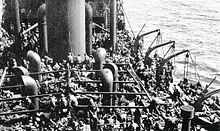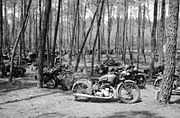Operation Ariel
| ||||||||||||||||||||||
| ||||||||||||||||||||||
Operation Ariel (sometimes Operation Aerial) was the name given to the World War II evacuation of Allied forces from ports in western France, from 15–25 June 1940, following the military collapse in the Battle of France against Nazi Germany. It followed Operation Dynamo, the evacuation from Dunkirk and Operation Cycle, the evacuation from Le Havre, which finished on 13 June.[1]
Background
Although Operation Dynamo at Dunkirk had evacuated much of the fighting element of the British Expeditionary Force, some combat units from 1st Armoured Division and Beauman Division and more than 150,000 support and line-of-communication troops had been cut off to the south by the German "dash to the sea".[2] In addition, the 52nd (Lowland) Infantry Division and the 1st Canadian Division had been rushed to France to bolster the defence of the west of the country. All these forces became known as the "Second BEF" and General Sir Alan Brooke was returned from England to command them.[1] Upon his arrival on 13 June, he quickly realised that there was no chance of success for them and that the French plan to fall back and make a stand in Brittany was unrealistic. Accordingly, in a telephone call on the evening of 14 June, he was able to persuade the British Prime Minister, Winston Churchill, that all the British troops in France ought to be disengaged and evacuated.[3] Historian Max Hastings asserts; "in that conversation, Brooke saved almost 200,000 men from death or captivity".[4]
Evacuation from Cherbourg and St Malo

The evacuation of 52nd Division from Cherbourg was under the command of Admiral William Milbourne James Commander-in-Chief, Portsmouth. He directed the larger troop and cargo ships to operate from Southampton, smaller coastal ships to use Poole and Dutch schuyts to work from Weymouth. Most of 52nd Infantry and 1st Armoured Divisions embarked between 15–17 June. Beauman Division and Norman Force, which were composite formations, left on the evening of 17 June. The rearguard battalion was evacuated in the afternoon of 18 June; the first German troops were entering the outskirts of the town as the last ship sailed at 4 pm.[5] 30,360 men had been evacuated and taken to Portsmouth. At St Malo, 21,474 men, mostly of the 1st Canadian Division, were evacuated on 17 and 18 June.[6] The Canadian division suffered six losses during its brief excursion to the Continent; five missing and one killed.[7]
Evacuation from Brest, St Nazaire and La Pallice
The evacuation from the more westerly ports was commanded by Admiral Sir Martin Eric Nasmith, the Commander-in-Chief of the Western Approaches Command based in Devonport. The evacuation from Brest was undertaken by a large flotilla of ships including the troopships Arandora Star, Otranto, and Strathaird.[8] 28,145 British and 4,439 Allied personnel, mostly RAF groundcrew, were taken off on 16 and 17 June without any major interference by the Luftwaffe and were landed at Plymouth.[9]
Waiting at St Nazaire were a large number of British Army support and logistic units, RAF personnel, Belgian, Czech and Polish troops as well as British civilians. The flotilla sent included the large troopships Georgic, Duchess of York, Franconia, RMS Lancastria and Oronsay. The Franconia was damaged by bombs en route and returned to Plymouth. Most of the larger ships had to anchor in Quiberon Bay because of the difficulty of navigating the narrow channel up the Loire estuary to St Nazaire.
During 17 June, troops were ferried out from St Nazaire to the large troopships via destroyers and coasters. The troopships were under orders to embark as many personnel as possible and soon became very crowded. At 2 pm there was an air raid by German bombers and the Oronsay was hit by a bomb on the bridge. In a second raid at 3:45, the Lancastria was hit by four bombs, which penetrated the hold packed with troops and ruptured the fuel oil tanks. Within 20 minutes the ship heeled over and sank; although 2,447 of those on board were saved, there was a death toll of around 4,000 (estimates vary from under 3,000 to 5,800), the largest loss of life in British maritime history.[10]
The last British troops left on the morning of 18 June in two convoys of small merchant ships and headed for Plymouth. Due to faulty intelligence which suggested that the Germans were closer than they actually were, much valuable equipment was left behind. A final mission arrived at St Nazaire on 19 June to evacuate 8,000 Polish troops who had been reported to have arrived at the port; in the event, there were only 2,000.
Further south at La Pallice (the commercial harbour of La Rochelle), the senior British naval officer found that no ships had been sent for the British and Polish troops waiting at the port. He therefore requisitioned a number of French merchant ships and left on 18 June. Thereafter, two flotillas of British ships arrived to pick up late arriving Poles; in all, 10,000 British and more than 4,000 Polish personnel were rescued from La Pallice.[11]

Evacuation from Bordeaux, Le Verdon, Bayonne and St Jean-de-Luz
Evacuation started from Bordeaux on 17 June by Royal Navy cruisers and destroyers and by Allied merchant ships that were still in the harbour. HMS Berkeley (Lt Cdr H G Walters), a Hunt-class destroyer, was made available to Paul Reynaud and the French Government as a venue for discussions with Churchill. After the fall of France, the ship evacuated the remaining British Consulate staff from Bordeaux. British diplomatic staff and the President of Poland and his cabinet were given priority. The remainder were mainly Polish and Czech troops. Evacuation continued at the nearby ports of Le Verdon and Bayonne, assisted by the troopships Batory, Sobieski (both Polish), Ettrick and Arandora Star. These ships then moved on to St Jean-de-Luz where the evacuation ended at 2 pm on 25 June, just after the deadline set by the terms of the Armistice. On the final day of the operation, the Canadian destroyer Fraser was accidentally rammed and sunk by the anti-aircraft cruiser Calcutta in the Gironde estuary.[12] Minor evacuations continued from the Mediterranean coast of France until 14 August 1940.
Aftermath
The number of people evacuated from France to Britain during Operation Ariel were:
- British – 144,171
- Polish – 24,352
- French – 18,246
- Czech – 4,938
- Belgian – 163
In total, 191,870 allied soldiers, airmen and civilians.[13] Although much equipment was lost, 310 artillery guns, 2,292 vehicles, 1,800 tons of stores,[14] 13 light tanks and 9 cruiser tanks were recovered.[15]
Gallery
_in_France_1939-1940_F4689.jpg) A column of British soldiers retreating to the Channel ports: June 1940 |
_in_France_1939-1940_F4756.jpg) British soldiers destroy stores at a Royal Army Service Corps depot: June 1940 |
_in_France_1939-1940_F4847.jpg) Motor transport on the quay at Cherbourg awaiting evacuation |
 British and French troops on leaving Cherbourg en route for Southampton, 13 June 1940 |
 British troops board a troopship at Brest, June 1940 |
 Exhausted troops rest aboard the troopship Guinean at Brest June 1940 |
 Abandoned British Army motorcycles at Monce-en-Belin near Le Mans, 13 June 1940 |
References
- ↑ 1.0 1.1 Operation Cycle, the evacuation from Havre, 10–13 June 1940. Historyofwar.org. Retrieved on 28 March 2011.
- ↑ Ellis, p. 296
- ↑ Alanbrooke, War Diaries 1939–1945, entry 14 June 1940
- ↑ Finest Years: Churchill as Warlord 1940–45, Max Hastings, Harper Press 2009, ISBN 978-0-00-726368-4 (p.51)
- ↑ Supplement to The London Gazette of Tuesday 21 May 1946 Appendix B (p 2439)
- ↑ Ellis, p. 302
- ↑ Stacey, C.P. Official History of the Canadian Army in the Second World War Volume I
- ↑ 10 June, Monday. Naval-history.net. Retrieved on 28 March 2011.
- ↑ Ellis, p. 303
- ↑ The Sinking of the Lancastria, Jonathan Fenby, 2005 Simon & Schuster UK Ltd, p.247
- ↑ Ellis, p. 304
- ↑ Allied Warships of WWII – Destroyer HMCS Fraser. uboat.net (22 October 1940). Retrieved on 28 March 2011.
- ↑ Ellis, p. 305
- ↑ "Operation Aerial, the evacuation from north western France, 15–25 June 1940". Military History Encyclopedia on the Web. Retrieved 21 December 2010.
- ↑ Ellis, p. 327
Bibliography
- Ellis, L. F. (1954) The War in France and Flanders 1939–1940. J. R. M. Butler (ed.). HMSO. London
Coordinates: 49°29′24″N 0°06′00″E / 49.49000°N 0.10000°E
